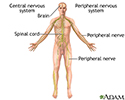Restless legs syndrome
Nocturnal myoclonus; RLS; Akathisia
Restless legs syndrome (RLS) is a nervous system problem that causes you to feel an unstoppable urge to get up and pace or walk. You feel uncomfortable unless you move your legs. Moving stops the unpleasant feeling for a short time.
Causes
No one knows exactly what causes RLS. It may be due to a problem with the way brain cells use dopamine. Dopamine is a brain chemical that helps with muscle movement.
RLS may be linked to some other conditions. It may occur more often in people with:
- Chronic kidney disease
- Diabetes
- Iron deficiency
-
Parkinson disease
Parkinson disease
Parkinson disease causes certain brain cells to die. These are the cells that help control movement and coordination. The disease leads to shaking ...
 ImageRead Article Now Book Mark Article
ImageRead Article Now Book Mark Article -
Peripheral neuropathy
Peripheral neuropathy
Peripheral nerves carry information to and from the brain. They also carry signals to and from the spinal cord to the rest of the body. Peripheral n...
 ImageRead Article Now Book Mark Article
ImageRead Article Now Book Mark Article - Pregnancy
- Multiple sclerosis
RLS may also occur in people who:
- Use certain medicines such as calcium channel blockers, lithium, or neuroleptics
- Are stopping sedative use
- Use caffeine
RLS occurs most often in middle-aged and older adults.
RLS is commonly passed down in families. This may be a factor when symptoms start at a younger age.
Symptoms
RLS leads to unpleasant feelings in your lower legs. These feelings cause an unstoppable urge to move your legs. You may feel:
- Creeping and crawling
- Bubbling, pulling, or tugging
- Burning or searing
- Aching, throbbing, or pain
- Itching or gnawing
These sensations:
- Are worse at night when you lie down
- Sometimes occur during the day
- Start or get worse when you lie down or sit for long periods of time
- May last for 1 hour or longer
- Sometimes also occur in the upper legs, feet, or arms
- Are relieved when you move or stretch as long as you keep moving
Symptoms can make it difficult to sit during air or car travel, or through classes or meetings.
Stress or emotional upset can make symptoms worse.
Most people with RLS have rhythmic leg movements when they sleep. This condition is called periodic limb movement disorder.
All of these symptoms make it hard to sleep. Lack of sleep can lead to:
-
Daytime sleepiness
Daytime sleepiness
Drowsiness refers to feeling abnormally sleepy during the day. People who are drowsy may fall asleep in inappropriate situations or at inappropriate...
Read Article Now Book Mark Article - Anxiety or depression
- Confusion
- Difficulty thinking clearly
Exams and Tests
There is no specific test for RLS. Your health care provider will take your medical history and do a physical exam. You may have blood tests and other exams to rule out conditions that can cause similar symptoms.
Usually, your provider will determine whether you have RLS based on your symptoms.
Treatment
RLS can't be cured. However, treatment can help relieve symptoms.
Certain lifestyle changes may help you cope with the condition and ease symptoms.
- Get enough sleep. Go to bed and wake up at the same time every day. Make sure your bed and bedroom are comfortable.
- Try using hot or cold packs on your legs.
- Help your muscles relax with gentle stretches, massage, and warm baths.
- Take time out of your day to just relax. Try yoga, meditation, or other ways to ease tension.
- Avoid caffeine, alcohol, and tobacco. They may make symptoms worse.
Your provider may prescribe medicines to treat RLS.
Some medicines help control symptoms:
- Pramipexole (Mirapex)
- Ropinirole (Requip)
- Low doses of narcotics
Other medicines can help you sleep:
- Sinemet (combination carbidopa-levodopa), an anti-Parkinson medicine
- Gabapentin and pregabalin
- Clonazepam or other tranquilizers
Medicines to help you sleep may cause daytime sleepiness.
Treating conditions with similar symptoms such as peripheral neuropathy or iron deficiency can also help relieve symptoms.
Iron deficiency
Anemia is a condition in which the body does not have enough healthy red blood cells. Red blood cells provide oxygen to body tissues. There are man...

Outlook (Prognosis)
RLS is not dangerous. However, it can be uncomfortable, make it hard to sleep, and affect your quality of life.
Possible Complications
You may not be able to sleep well (insomnia).
When to Contact a Medical Professional
Call for an appointment with your provider if:
- You have symptoms of RLS
- Your sleep is disrupted
- Symptoms get worse
Prevention
There is no way to prevent RLS.
References
Aurora RN, Kristo DA, Bista SR, et al. The treatment of restless legs syndrome and periodic limb movement disorder in adults-an update for 2012: practice parameters with an evidence-based systematic review and meta-analyses: an American Academy of Sleep Medicine Clinical Practice Guideline. Sleep. 2012;35:1039-1062. PMID: 228511801 www.ncbi.nlm.nih.gov/pubmed/22851801 .
Bogan RK, Cheray JA. Restless legs syndrome: a review of diagnosis and management in primary care. Postgrad Med . 2013;125:99-111. PMID: 23748511 www.ncbi.nlm.nih.gov/pubmed/23748511 .
Chokroverty S, Avidan AY. Sleep and its disorders. In: Daroff RB, Fenichel GM, Jankovic J, Mazziotta JC, eds. Bradley's Neurology in Clinical Practice . 6th ed. Philadelphia, PA: Elsevier Saunders; 2012:chap 68.
Lang AE. Other movement disorders. In: Goldman L, Schafer AI, eds. Goldman's Cecil Medicine . 25th ed. Philadelphia, PA: Elsevier Saunders; 2016:chap 410.
-
Nervous system - illustration
The central nervous system is comprised of the brain and spinal cord. The peripheral nervous system includes all peripheral nerves.
Nervous system
illustration
-
Restless legs syndrome and related disorders
(In-Depth)
Review Date: 8/13/2015
Reviewed By: Joseph V. Campellone, MD, Division of Neurology, Cooper University Hospital, Camden, NJ. Review provided by VeriMed Healthcare Network. Also reviewed by David Zieve, MD, MHA, Isla Ogilvie, PhD, and the A.D.A.M. Editorial team.

